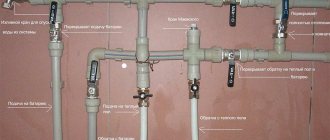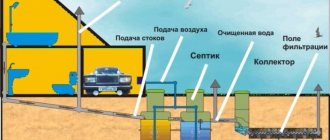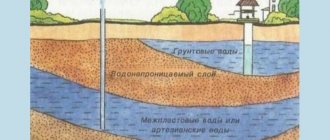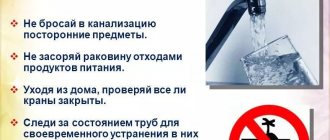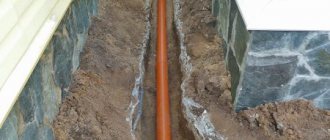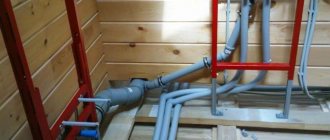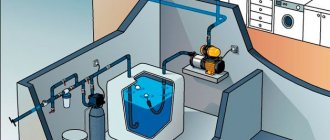The best price for the design of engineering systems!
Owning a house outside the city is not only an excellent opportunity to fully relax from the hustle and bustle of the metropolis, but also a good way to demonstrate your respectability. In both cases, country real estate must provide the owner and his guests with all the benefits of civilization, among which perhaps the most important place is occupied by water supply and sewerage systems. Firstly, it is convenient from the point of view of hygiene and food preparation. Secondly, it allows you to ensure proper sanitary condition of the house and surrounding area. Thirdly, a small but tangible plus for the fire safety of the home.
You say: what could be simpler than installing a water supply system by installing taps, washbasins and other plumbing fixtures in the right places? And you will be completely wrong. There are a lot of nuances, without taking into account which it will be, if not impossible, then certainly difficult to use water supply and sewerage. Especially if both the water supply and wastewater disposal are supposed to be autonomous. Behind every properly functioning and year-round engineering network there is a strict calculation and professional installation. can provide you with both. Our design bureau is ready to create a water supply and sewerage project for a cottage or country house. The price depends on the area and number of floors of the building, as well as on the degree of its provision with sanitary equipment.
Cost of engineering systems design. Price per m2
| Name of works | Cost of work |
Wiring diagram | |
| Drawing up a house water supply diagram (HS, DHW) | 75 RUR/m2 |
| Drawing up a diagram of a water treatment and purification system | 40 RUR/m2 |
| Drawing up a diagram of internal sewerage | 75 RUR/m2 |
| Drawing up a storm drainage diagram | 40 RUR/m2 |
Project | |
| Drawing up a house water supply project (HS, DHW) | 120 RUR/m2 |
| Drawing up a project for a water treatment and purification system | 55 RUR/m2 |
| Drawing up an internal sewerage project | 120 RUR/m2 |
| Drawing up a storm sewer project | 55 RUR/m2 |
| Surveyor's visit, consultations, estimate preparation - free of charge Call a surveyor | |
The complexity of a water supply project depends on whether there is the possibility of a centralized water supply, or whether it is necessary to drill a water well with the installation of pumping equipment and, possibly, a filtration unit. The latter depends on the quality of the supplied water and is determined by the results of the examination.
“Cottage Expert” is engaged in the design and construction of houses, so any project created by our specialists can, at the request of the client, be translated into reality by the company’s construction division. All work performed is guaranteed.
Design of water supply systems and networks
Designing water supply networks is very important for builders, since the water supply and sewerage project has already resolved issues that allow saving money and time during installation work. The finished project already has thorough and detailed answers to questions about:
- what thickness of the screed should be so that the water pipes fit in the floor;
- what pipes should be chosen to avoid leaks;
- what water supply system should be adopted for the facility;
- how to properly connect a water heater for a hot water supply system;
- how much material and equipment for installing water supply and sewerage needs to be purchased.
Water supply plan
Not only builders rely on high-quality water supply and sewerage projects. If you can do without it during cosmetic repairs, then during major repairs you can’t. In the latter case, water supply design is mandatory in case of changes in water consumption volumes, for connecting to external networks and making changes to utility networks. In addition, water supply design will be required to obtain permission to begin construction work from the operating organization.
Installation of a sewerage and water supply system, of course, can be done without a project, but in this case the imaginary savings will cost much more. In the absence of designing water supply networks, you may encounter a number of problems, among which the overuse of water supply pipes will not be the worst, but the wrong choice of water supply pipes will be much worse, as a result of which leaks and, as a result, flooding of neighbors are possible. Competent design of water supply, subject to high-quality implementation of design solutions, is a guarantee of trouble-free and long-term operation of the entire water supply system.
Connecting the water heater
How to install water supply from a well to a private house
Equipping a country house with plumbing involves several main stages.
- If there is no well yet and the decision to create one is just being made, it is necessary to decide on its depth. Here you should know that a sandy source with a depth of no more than 50 m is unlikely to be suitable for year-round consumption. Such a well can be drilled if the house is a summer house and water is not used daily, or if the liquid consumption is very small.
For a building with several rooms where people constantly live, it is better to drill an artesian source 100 meters or more deep.
- Next, you need to purchase a pump that will ensure trouble-free water supply to the house. It is better to select a device in a store after consultation with a specialist. The best choice is a submersible pump with a pipe outlet of ¾ inch or higher. For such a unit, it is advisable to purchase a kind of control panel - a hydraulic device, which serves to automatically supply and shut off water, and will also show the flow rate and level of the liquid.
If the well is shallow, you can install a pumping station, which is a regular unit with a hydropneumatic tank located in any convenient room in the house. You can also purchase a pressure gauge and other devices (if they are not built-in) that determine the quality of the pump.
- The next step is to purchase pipes. The diameter of the pipes will depend on their total length:
- with a water pipeline length of no more than 30 m, the pipe diameter is 25 mm;
- for a length of more than 30 m – diameter 32 mm;
- with a length of less than 10 m - diameter 16 - 20 mm.
It is also necessary to consider the number of taps in the house. One tap flows about 5 liters of water per minute. When selecting a collector pipe, it should be taken into account that:
- diameter 25 mm passes 30 liters of liquid in 1 minute;
- diameter 32 mm – 50 l;
- diameter 38 mm – 75 l.
You can choose any material for making pipes from those on the market: metal-plastic, copper, steel, cross-linked polypropylene.
Difficulties in designing water supply and sewerage systems
There are many factors to consider when designing water supply and sewer systems. First of all, it is worth noting that all projects must be carried out in compliance with relevant norms and regulations. Among them:
- SNiP 2.04.02-84* “Water supply. External networks and structures – for external water supply networks;
- SNiP 2.04.01-85* “Internal water supply and sewerage of buildings” - for internal water supply networks.
- In accordance with GOST 21.601-79 “Water supply and sewerage.” and GOST 21.604-82 “Water supply and sewerage. External networks" drawings must be completed.
Designing water supply and sewerage for a country house or apartment in accordance with the requirements and wishes of customers requires the implementation of some important steps before starting design work. First of all, it is necessary to collect initial data. To do this, you should find out what the volume of water consumption will be (how many people will live in the house), whether there is any additional equipment that requires a water supply connection. Next, the balance of water supply and sanitation is calculated, which is carried out on the basis of Appendix 2 from SNiP 2.04.01-85 * “Internal water supply and sewerage of buildings.
Water consumption depends on the number of water consumers and the purpose of the building. The appendix provides water supply costs for each type of building, including for each appliance. For example, one administrative employee consumes 16 liters of tap water per day, and a resident of a residential building consumes 150-300 liters, depending on the water supply system and the type of residential building. When calculating the water supply balance, it is necessary to take into account the probabilities of opening the device depending on how many people there are per plumbing fixture. And most importantly, it is a source of water supply. This can be a central city network or an autonomous well.
In addition, when designing a water supply, it is necessary to determine the source or method of preparing hot water. Hot water can come from central networks, be prepared centrally in the building’s heat exchanger, or in an individual gas or electric water heater. When designing water supply and sanitation systems, it is necessary to plan the premises with plumbing fixtures, equipment and other water consumers marked on them. It is possible to significantly speed up and reduce the cost of water supply and sewerage design by providing layouts in electronic form - in dwg format. If operating organizations (housing departments, housing departments, management companies, etc.) have their own special requirements, they must also be known before the start of design work on the water supply system.
The initial data for the design of external water supply networks are technical conditions for connection, general plan, geology and topography of the site. Existing communications must be marked on the general plan.
After the initial data has been collected, it is necessary to formulate a technical specification for the design of a water supply system. Our specialists will help you do this. You can fill out the task yourself; to do this, download the technical specification template file or fill out the form on our website. Well, when the task is drawn up, the design contract is signed, the design process begins.
Axonometric diagram of water supply
Water supply schemes for industrial enterprises
The water supply system at the enterprise is equipped according to one of three schemes:
- Direct flow.
- Consistent.
- Negotiable.
This depends on the details of the production processes, equipment, location of the enterprise itself and ways of further use of waste water.
So, in the first case, a necessary condition is the presence of a large source of water nearby (no further than 5 km) from the production. In this case, the water supply height (geodetic height) should not be higher than 25 m. After completing the technological process, the water is discharged into the reservoir.
A consistent water supply scheme for an enterprise implies the reuse of water, which reduces the consumption of the resource taken from the source. Purification of waste water is usually not provided for in such a water supply, so this scheme is used if during the production process the water is not contaminated with harmful chemical or mechanical impurities.
Recycling water supply of industrial enterprises
The most complex water supply scheme for industrial enterprises is the recycling system. In this case, water supply is organized in a closed, repeating cycle, but with a mandatory water purification process.
This is the scheme:
- firstly, it is environmentally friendly, since it eliminates the discharge of contaminated water into urban reservoirs or sewers;
- secondly, it is economical - it allows you to reduce (almost 100%) the water consumption of the enterprise and avoid fines for exceeding the maximum permissible concentration.
Modern purification technologies and devices are capable of removing waste water from mechanical, biological, and chemical impurities. Today, through special manipulations, it is possible to rid water of heavy metal ions and excess salts, which allows you to return an exceptionally pure resource to nature.
Technical water supply for industrial enterprises
What any technical water supply system of an enterprise should include is a whole complex of various structures and devices for:
- fence;
- cleansing;
- storage;
- filing;
- redistribution of water resources.
More specifically, a water supply scheme is a system consisting of the following components:
- water intake structures – the function of collecting water from a natural reservoir;
- pumping stations - they supply water either to a special settling pond or directly through a pipeline; they can be of several levels, depending on their purpose;
- settling ponds – preliminary water purification;
- purified water reservoirs, where water that has undergone primary purification is stored for the required time;
- storage ponds;
- a water tower, which is needed in order to ensure the proper pressure of the water stream;
- chemical water treatment plants (CWTP);
- drainage systems
Additionally, the system includes parts for shut-off and control equipment, water supply networks, etc.
The designer draws up a detailed plan for their location on the territory of the enterprise, depending on the capacity, purpose, and structural characteristics of buildings and structures. The main principle that both project customers and implementers are focused on today is minimal consumption of water resources combined with maximum use of waste water and other production waste.
Design of water supply and sewerage
Typical composition of a water supply and sewerage project (section VK):
- Title page
- General information about the project
- Composition of the water supply and sewerage project
- Balance of water consumption and wastewater disposal
- Explanatory note
- Floor plans with sewerage networks, storm drainage, industrial sewerage
- Floor plans with hot and cold water networks
- Axonometric diagram of sewerage, storm sewerage, industrial sewerage
- Axonometric diagram of hot and cold water supply
- Units and parts of water supply and sewerage systems if necessary
- Water metering unit diagram
- Sewage system specification
- Sewage system specification
In addition to the quality of the project, the timing and cost of design are no less, and sometimes even more important for the customer. We are ready to perform and constantly perform feats of labor for our clients. In exceptional cases, design time is from two days. Typically, the completion time for a water supply and sewerage project is one to two weeks. For small facilities, the cost of a water supply and sewerage project is 9 – 12 thousand rubles. You can find out more about the prices for water supply and sewerage projects, for the design of water supply and heating, as well as other systems in the special section - design prices.
Entrust the design to professionals!
Contact the GIP company, we will advise you free of charge if you have any questions by phone: +7 499 6772176 or by e-mail: [email protected]
Selection of materials
Pipes made of copper, metal-plastic, and polypropylene are popular for internal water supply.
A water supply and sewerage project includes the selection of pipelines with the required parameters. The industry produces a wide range of pipes for drinking water and waste liquids.
Pipeline materials:
- metal-plastic,
- cast iron,
- steel,
- copper,
- polyethylene,
- polypropylene,
- polyvinyl chloride,
- fiberglass,
- asbestos,
- reinforced concrete.
The most common products are made of polymers, metal-plastic, and stainless steel. Internal water pipes are made of PPRC polypropylene, metal-plastic, PEX cross-linked polyethylene, corrugated stainless steel. Internal drain pipes are made from PP polypropylene, gray PVC and HDPE high density polyethylene.
For external water supply systems, products made of PE polyethylene and polyethylene with a PE-RC protective layer are used. External drainage systems are made of orange polyvinyl chloride, corrugated polyethylene and corrugated two-layer PP polypropylene.
The designer decides on the type of pipe, based on the technical specifications of the project, the advantages and disadvantages of the material, and also takes into account the wishes of the customer.
Sewerage project
Drainage and water supply are so closely related that it is best to order both projects at the same time. This is both cheaper and more rational - it is possible to eliminate unnecessary technological components. The cost of designing a sewer system for a house is relatively low; Celsis does not inflate prices.
The development of a sewerage project must be carried out professionally, because the main causes of leaks and blockages are errors during the installation of the system.
A competent project is done on the basis of careful calculations:
- it is necessary to do the tracing correctly,
- strictly observe the slope when installing highways,
- provide the required number of inspection and inspection wells,
- calculate the volume of the septic tank and specific indicators of water disposal,
- determine the speed of movement of the withdrawn liquid.
What determines the cost of design work?
The total cost of designing engineering systems depends on several factors and is determined by a set of tasks. The main component of the cost of engineering networks and systems is the complexity of the construction part of a building or cottage, its area or layout.
Another cost component is the complexity and ramification of internal or external networks, their interaction with each other and the linking of all networks into a single whole. An example of such a solution is the increasingly popular Smart Home.
Also, the price of designing engineering systems for a private house is influenced by the selective or complete composition of the documentation performed.
Negative consequences of an unprofessionally executed project
Competent design of the engineering systems of a private home eliminates additional costs associated with installation work. The second side of unprofessionally performed design work is higher costs for equipment and costs for maintaining communications during operation.
Among the typical errors or inaccuracies in engineering technical design, several common cases of additional costs during construction or operation should be noted:
- Incorrect calculation of the building's heat losses in the heating project leads to inflated costs for the heating circuit or insufficient heating power of the heating boiler
- Poor plumbing engineering often requires raising the overall floor level to ensure reliable drainage of plumbing fixtures
- Separate design of ventilation and heating systems can increase operating costs for heating outdoor air during the cold season
- Errors in engineering calculations and design of ventilation and air conditioning often lead to the installation of additional attachments and disruption of the overall design project of the cottage
The MosInzhGroup company provides high-quality design, installation of engineering systems and subsequent service. The result of our work is trouble-free functioning communications at our Customers' sites.
Types of systems
All systems can be divided into 2 types:
- Pressure system.
- Non-pressure.
Gravity sewerage
Gravity drainage is used everywhere, the main thing is to maintain the required angle so that the wastewater reaches its destination. The use of this type is the most common and is used for all types of drainage.
Pressure sewerage involves the use of a pump. Sometimes the geographical location of the house does not allow the use of the simplest non-pressure sewer system. This is possible when the house is located below the main ground level, or it means using the basement of the house where the bathroom is planned to be located.
Pressure sewer
The pressure one does not need to maintain the angle of inclination of the pipes, has a lower likelihood of clogging, and also makes it possible to use a system of smaller diameter.
With all these positive aspects, there is a need to purchase a fairly expensive pump that will be able to serve a fairly large area.
A septic tank or central sewer is used as a waste storage facility for such a system. The well is simply not able to cope with the volume of water that will flow.
Another noticeable disadvantage is the energy consumption to ensure the operation of the pumping station. For ordinary water, a low-power pump is enough, which practically does not experience high loads. Due to the fact that the system contains such a unit as a toilet or kitchen sink, a sufficiently large pumping station is required.
Its operating principle is based on the initial collection of wastewater in a reservoir at the pump. After the tank is filled, all liquid is pumped into a septic tank or central sewer system.
But there is also a risk of damage to the pump from solid objects present in the wastewater. All human waste products must be recycled to eliminate the possibility of breakdown. To do this, a grinder is installed at the pumping station, which easily copes with the task.
Thus, when using this method, there is a need to install a fairly large and expensive station, which will require a lot of space for installation.
Cottage water supply equipment
If a water supply system from a well or borehole is being designed, then, first of all, the type of alluvial equipment is determined. For a well, deep and surface models are used; for a well, submersible and surface models are used. The latter are installed on the surface next to a well or borehole, hence their name. The latter are lowered into the hydraulic structure.
Submersible ones are installed at a shallow depth - not lower than 10 m. Deep ones can be lowered to 200 m. Therefore, their design is more powerful and airtight.
How to calculate pump power
The calculation is based on the number of plumbing fixtures in the house and their performance. For example:
- kitchen sink – 12 l/sec;
- washbasin – 12 l/s;
- shower – 0.25 l/sec;
- toilet - 0.1 l/sec.
Here you must definitely add taps located in the yard and used for watering the garden. Their consumption is 0.3 l/s.
The total value of all plumbing fixtures is the performance of the installed pump. But this type of equipment has one more important parameter - pressure. It determines how far or how high the pump can deliver water. This is an important parameter because the water intake is installed from a depth. For example, if a well is drilled to a depth of 20 m, then the pressure of the selected pump should not be less than this value.
Based on the two obtained indicators, you can select the required pump from the catalog. It is clear that the higher these two characteristics, the more expensive the pumping equipment. For example, deep models are the most expensive:
| Pump brand | Flow, m3/h | Head, m | price, rub. |
| Grundfos SQ 3-105 | 4,4 | 147 | 65000 |
| Waterstry SPS 7025 | 18 | 163 | 94000 |
| Waterstry 3ST 2- 90 | 2,8 | 116 | 13000 |
| Grundfos Package SQE 5-70 with frequency control | 8 | 106 | 115000 |
Additional type of equipment for autonomous water supply
Since water from wells and boreholes is not always clean, it is therefore very important to take care of its purification. Today, filters for various purposes are used for this, providing different degrees of purification. Usually these are coarse and fine filters. The former retain large impurities (sand, pebbles, etc.), the latter - small ones. They are installed in this sequence.
In addition to these types of filters, there are others:
- for water softening;
- for ionization;
- for disinfection.
Another element of an autonomous water supply network is a storage tank. Its purpose is to store water in case the electricity supply is cut off in a country village, which happens quite often. In such a situation, the pumps will not be able to work, and water will be supplied to the network from this tank. Its volume depends on the parameters of water consumption by the residents of the house. Usually in a small cottage a plastic container with a volume of 1 m3 is installed.
As for the location for installing additional equipment, it is best to use a utility room - a basement, a separate room isolated from living quarters. The main thing in the project is to take into account that the distance from the well or well to the internal water supply network should be as short as possible.
